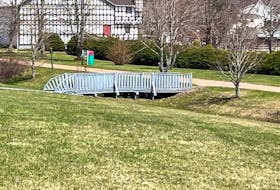SUMMERSIDE
Distinctive songs fill the crisp Saturday morning air as a small group flocks to the western end of MacKenzie Drive, poised with binoculars and cameras in hand, with the hope of capturing a variety of bird species along the Summerside boardwalk.
Donna Martin, a member of Nature P.E.I., can identify spring migrants and resident birds stock still and camouflaged on leaf littered grounds, hidden under the canopy of trees or soaring through the sky, by making sense of their sounds.
“It’s called mnemonics and it helps you recall bird songs,” she said, while leading the group of birding enthusiasts down the boardwalk recently.
“For example, if you are looking for white-throated sparrows then listen to the last few notes of their song because it sounds like the national anthem, ‘O Canada.’ ”
Mnemonics helps string together the syllables and notes of a bird’s song by using a catchy phrase, so it’s easy to remember its pitch, tempo and rhythm for identification.
Martin, a wildlife technician by trade, acknowledged learning to identify birds by their songs and call notes can come in handy when a habitat is not accessible, although there is one highly intelligent bird that can mimic other species.
“I once thought I was following the call of a red-tailed hawk and came across a blue jay impersonating the species. It was the very first time I experienced it.”
She noted, “If you ever see raptors (birds of prey) come into the area, all the other birds disappear. My guess is that this jay may have mimicked the raptor to gain access to their coveted food source. They are a very smart bird and have an impressive vocal repertoire that goes beyond their raucous ‘jay, jay’ call.”
At a glance
For more information about Nature P.E.I., a not-for-profit organization, visit www.naturepei.ca
As the group walked further through each habitat, from the shoreline, marshes, woodland and open grounds, different songs could be heard.
“Early morning is the best time to spot the birds and hear them singing,” said Martin, while she pointed out an American robin, yellow-bellied sapsuckers, American crow, mallard, downy woodpecker, belted kingfisher and even osprey, to name a few of the 26 species spotted on this walk.
“I’ve been birding since I was a child. I have always loved nature and conservation. We have a lot of birds that are declining across the board, so for me it’s a personal love of nature and being outdoors.
“The more you get to know the birds, the more you start looking at their habitat and why it’s so important to preserve. When we are cutting down all their homes, this is one of the biggest reasons why we are losing a lot of the species.”
Martin suggests a great resource to aid in identifying feathered friends is “Dendroica.”
“You have to sign up to use (the website), but it’s free and there are always birds out there that stump even the best of the best.”








